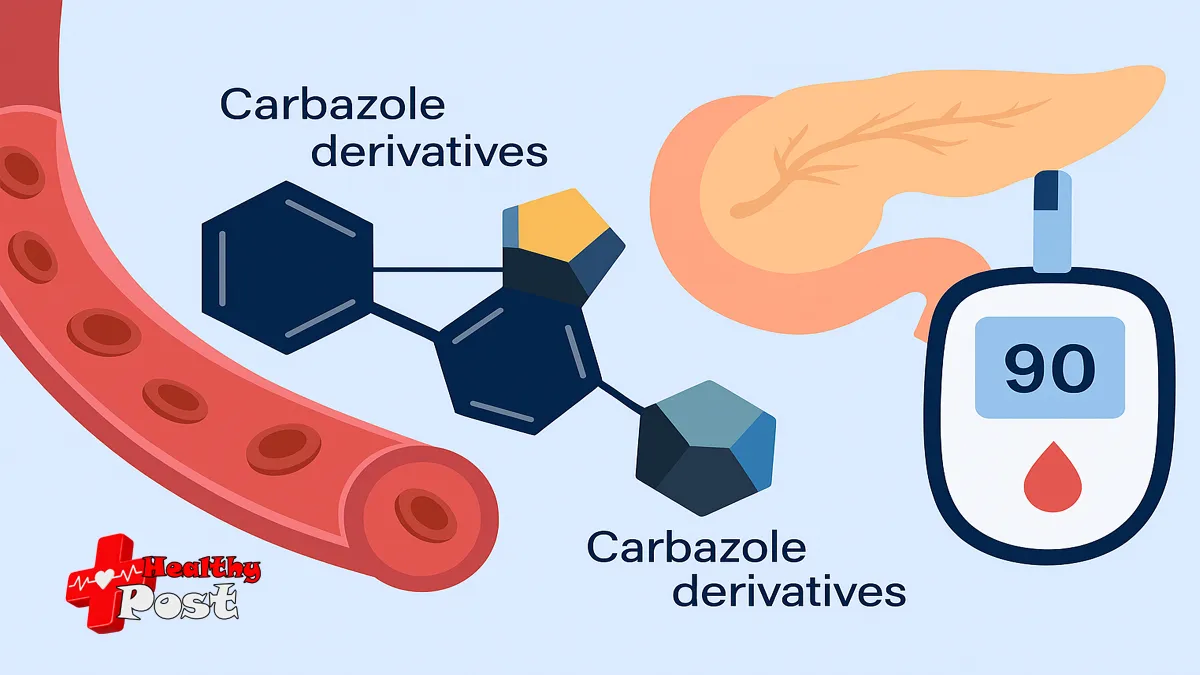
Carbazole derivatives help regulate blood glucose and may support diabetes management
If you’re managing blood sugar or helping a loved one with diabetes, you’ve probably felt overwhelmed by the flood of new research and supplements out there. One interesting area scientists are looking into is carbazole — a chemical structure found in some natural plant compounds — because its derivatives appear to affect blood glucose and related pathways. This article walks through what that means in plain language, highlights clear benefits being studied, and gives practical, safe ideas you can talk over with your healthcare team.
What is carbazole (in plain terms)?
Carbazole is a chemical “building block” that appears in nature and in some lab-made molecules. When scientists tinker with that structure they create “carbazole derivatives.” Researchers have been studying certain derivatives because they show effects on inflammation, oxidative stress, and how the body handles sugar. Important: most of the promising results come from lab and animal studies. That means we should be hopeful but cautious while waiting for more human research.
How to read this guide
- Clear, numbered benefits are listed below so you can scan quickly.
- Short paragraphs and examples help the science feel real.
- There’s a simple comparison table showing levels of evidence.
- I’ll also explain safety, practical steps, and a quick Rank Math SEO note if you’re publishing this on a blog.
Numbered benefits of carbazole derivatives for blood glucose and diabetes management
Benefit 1 — Carbazole derivatives may improve insulin sensitivity
Why this matters: Insulin sensitivity is how well your cells respond to insulin to take glucose out of the bloodstream. Poor sensitivity (insulin resistance) is a core problem in type 2 diabetes.
What researchers have observed:
- Some carbazole derivatives appear to boost signals in cells that help insulin do its job.
- Studies in muscle and fat cell lines and in animal models show improved glucose uptake after treatment with certain carbazole-based compounds.
Real-life example:
Imagine your cells are doors and insulin is the key. If the key doesn’t fit easily (insulin resistance), glucose stays outside. In lab models, carbazole-like compounds have helped the key work better. That’s hopeful, but it doesn’t automatically mean the same effect happens in people.
Why this is helpful daily:
- Better insulin sensitivity can mean less blood sugar variability and fewer highs after meals.
- For people on lifestyle therapy or insulin-sensitizing drugs, an additional safe intervention could complement existing care — again, only with professional guidance.
Benefit 2 — Carbazole derivatives may support healthier pancreatic beta-cell function
Why this matters: Beta cells in the pancreas produce insulin. If these cells are damaged or exhausted, your body can’t regulate glucose well.
What researchers have observed:
- Some carbazole compounds show protective effects on beta cells in lab settings, helping them survive stressors like inflammation or high glucose.
- Antioxidant and anti-inflammatory properties of certain derivatives may reduce damage to these cells.
Real-life example:
Think of beta cells like battery chargers. If the charger gets hot or damaged, it stops charging; carbazole derivatives may help keep the charger cool and functioning better in lab studies. This is a hopeful signal for preserving long-term function.
Benefit 3 — Carbazole-related compounds have anti-inflammatory and antioxidant actions
Why this matters: Chronic inflammation and oxidative stress are strongly linked to diabetes progression and complications (like nerve or blood vessel damage).
What researchers have observed:
- Multiple carbazole derivatives reduce markers of inflammation and oxidative damage in cells and in animals.
- Reducing inflammation may indirectly help blood glucose control by improving insulin signaling and reducing stress on tissues.
Practical effect for daily life:
- Improving inflammation can help overall metabolic health.
- While a lab finding doesn’t directly translate to a pill you can take, the mechanism supports why carbazole derivatives are of interest.
Benefit 4 — Some carbazole derivatives may reduce glucose production in the liver
Why this matters: The liver makes glucose between meals. Excessive liver glucose production contributes to fasting high blood sugar.
What researchers have observed:
- In animal and cell studies, certain compounds lowered enzymes involved in glucose production, resulting in less glucose released from the liver.
- This could help reduce fasting blood sugar levels if replicated safely in humans.
Real-life example:
If the liver is a factory that keeps producing sugar, carbazole-like compounds may help slow that assembly line in experimental models — which would lower morning blood sugars.
Benefit 5 — Carbazole compounds may help reduce post-meal blood sugar spikes
Why this matters: Spikes after meals contribute to overall glucose burden and are linked to complications over time.
What researchers have observed:
- Some derivatives improved glucose uptake into tissues and slowed carbohydrate digestion enzymes in lab settings.
- These actions together could reduce the size of glucose surges after meals.
Practical tip:
Slowing post-meal spikes is something many people work on through portion control, fiber, and medication. If future human studies support it, carbazole-based options might become an additional tool.
Benefit 6 — Carbazole derivatives show potential synergy with lifestyle measures
Why this matters: No single compound fixes everything. The best results usually come from combined approaches.
What researchers have observed:
- In animal studies, carbazole derivatives paired with exercise or healthy diets tended to produce better results than either alone.
- This suggests they might complement lifestyle measures rather than replace them.
Real-life example:
Think of carbazole derivatives as a team player on the health team — they might boost the effectiveness of diet and activity but won’t replace either.
Benefit 7 — Potential to lower risk factors for diabetes complications
Why this matters: Beyond blood sugar, diabetes care is about reducing long-term risks such as heart disease, nerve damage, and kidney problems.
What researchers have observed:
- Because of anti-inflammatory and antioxidant effects, researchers are testing whether carbazole derivatives reduce markers of vascular damage and nerve injury in animals.
- Early results are promising but preliminary.
Practical cautious note:
We can be encouraged by the mechanisms, but human clinical trials are needed before we say carbazole derivatives prevent or treat complications.
Quick visual aid — Evidence summary table
This simple table shows where the evidence for carbazole derivatives stands today.
| Evidence type | Typical model | Key findings | Strength / limitation |
|---|---|---|---|
| In vitro (cells) | Muscle, fat, liver, beta cells | Improved glucose uptake, reduced inflammation and oxidative stress | Strong mechanistic insight, but not whole-body |
| Animal studies | Rodent diabetes models | Improved fasting and post-meal glucose, preserved beta cells | Encouraging, but animal metabolism ≠ human |
| Early human data | Very limited / preliminary | Few or no robust clinical trials yet | Requires human trials for safety/efficacy |
| Safety data | Toxicology in animals | Varies by compound; some derivatives show acceptable safety margins | Human safety profiles need defining |
What this table means for you:
- The science is promising in the lab and in animals.
- We still need larger, well-designed human clinical trials to confirm benefits and to establish safe dosing.
Safety, interactions, and practical cautions
I want to be very clear and empathetic here: exploring new compounds can feel hopeful, but safety must come first.
Key safety points:
- Most evidence so far comes from lab and animal studies. That doesn’t guarantee safety or effectiveness in people.
- Carbazole derivatives are a broad category. Effects and safety depend on the specific compound, dose, and purity.
- They could interact with diabetes medications (insulin, metformin, sulfonylureas, SGLT2 inhibitors, etc.), potentially changing blood sugar levels.
- Always talk to your doctor or diabetes care team before starting any supplement or experimental therapy. They can monitor blood sugar and medication needs.
What to ask your healthcare provider
- Is it safe for me to try a supplement containing carbazole derivatives with my current medicines?
- Are there known interactions with my diabetes medications?
- Can we monitor blood glucose more closely if I start something new?
- Are there reputable clinical trials I could join?
Real-life scenario
María, on metformin for type 2 diabetes, read about carbazole derivatives and wondered if she should try an herbal extract containing them. She talked to her nurse practitioner. Together they decided to wait for better human data but focus on proven steps: reviewing diet, encouraging walking after meals, and checking HbA1c in three months. This approach kept María safe and proactive.
Practical steps you can take now (without experimental supplements)
While waiting for clinical proof, here are safe, evidence-based actions that work for blood glucose management:
- Focus on consistent portion control and balanced plates (vegetables + protein + healthy fat + whole grains).
- Move after meals — short walks lower post-meal spikes.
- Sleep and stress management: both affect blood sugar.
- Stay on prescribed medications and attend regular checkups.
- If curious about trials or supplements, discuss with your provider first.
How researchers study carbazole derivatives (brief and simple)
- Scientists start in cells to see mechanisms.
- Promising compounds move to animal models to test whole-body effects and safety.
- The best step is randomized clinical trials in people — those are the studies that can prove benefit and safety.

